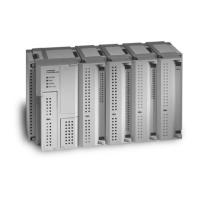OPENNET CONTROLLER USER’S MANUAL 17-1
17: USER COMMUNICATION INSTRUCTIONS
Introduction
This chapter describes the user communication function for communication between the OpenNet Controller and external
devices with an RS232C port. The OpenNet Controller uses user communication instructions for transmitting and receiv-
ing communication to and from external devices.
User Communication Overview
The user communication mode is used for linking the OpenNet Controller to an RS232C communication device such as a
computer, modem, printer, or barcode reader.
All OpenNet Controller CPU modules feature two RS232C ports to communicate with two external devices simulta-
neously.
User communication transmit and receive instructions can be programmed to match the communication protocol of the
equipment to communicate with. Possibility of communication using the user communication mode can be determined
referring to the user communication mode specifications described below.
User Communication Mode Specifications
Connecting RS232C Equipment through RS232C Port 1 or 2
To connect equipment with an RS232C communication port to the RS232C port 1 or 2 on the OpenNet Controller, use the
user communication cable 1C (FC2A-KP1C). One end of the user communication cable 1C is not provided with a connec-
tor, and it can be terminated with a proper connector to plug in to communicate with the RS232C port. See the figure on
page 17-2.
Standards EIA RS232C
Control Signal DSR, DTR, RTS
Baud Rate 1200, 2400, 4800, 9600, 19200 bps
Data Bits 7 or 8 bits
Parity Odd, Even, None
Stop Bits 1 or 2 bits
Receive Timeout
10 to 2540 msec (10-msec increments) or none
(Receive timeout is disabled when 2550 msec is selected.)
The receive timeout has an effect when using RXD1/RXD2 instructions.
Communication Method Start-stop synchronization system half-duplex
Maximum Transmit Data 200 bytes
Maximum Receive Data 200 bytes
Phone: 800.894.0412 - Fax: 888.723.4773 - Web: www.clrwtr.com - Email: info@clrwtr.com

